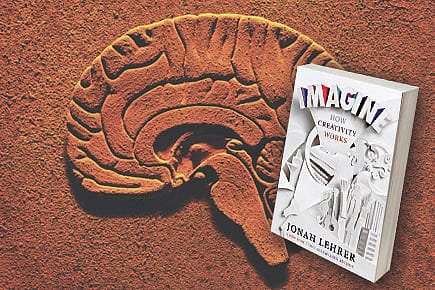Synaptic Sizzle

A book that puts the brain under a scanner to make scientific sense of creativity
Eggheads usually look at creative stuff the way clueless viewers look at stereograms: with both eyes wide open, but without the slightest inkling of anything going on that's beyond the obvious. Jonah Lehrer, thankfully, is an unusual egghead who appreciates art as an actual artist would and addresses the whizzle-crackle of neurons in an artist's head without making it sound like neurobabble. In his last book, Lehrer sought to explain how some artists had anticipated a few dramatic discoveries of neuroscience; Virginia Woolf's writing, for example, a blend of her selective sensations with her take on objective reality, set the stage for what modern science has found the conscious self, in essence, to be: 'The secret, Woolf realized, was that the self emerges from its source… [it] is simply our work of art, a fiction created by the brain in order to make sense of its own disunity.'
In Imagine, Lehrer asks the question of how big ideas strike. 'Every creative journey begins with a problem,' he writes, 'a feeling of frustration, the dull ache of not being able to find the answer.' For those new to the question, Lehrer throws in tales of creativity that are rather well known already. Velcro was inspired by burrs caught in a dog's fur. Gutenberg's printing machine took its mechanics from wine presses of the time. Nike's 'Just Do It' slogan had its origin in the last words—"Let's do it"—of a man about to be executed. Barbie was a 'salacious German figurine' that was mistaken for a child's doll.
2026 New Year Issue
Essays by Shashi Tharoor, Sumana Roy, Ram Madhav, Swapan Dasgupta, Carlo Pizzati, Manjari Chaturvedi, TCA Raghavan, Vinita Dawra Nangia, Rami Niranjan Desai, Shylashri Shankar, Roderick Matthews, Suvir Saran
That last story leaves my teeth gnashed in solidarity with worthy causes like sexual sanity and human equality, but this book's sizzle lies elsewhere: in Lehrer's guesswork about the brain's inner workings, and how the left hemisphere (which operates 'denotation' and logical thinking) surrenders the task of tackling tricky problems to the right half (which deals with 'connotation' and connects seemingly random dots: 'I link, therefore I am'). The climax of such a sizzle is what's familiar to us as that eureka moment, that aha point at which one gets a 'burst of gamma waves' from a small fold of tissue in the right hemisphere just above the ear, as brain scans reveal. This, Lehrer suggests, is exactly what Bob Dylan had in 1965, when, on the cusp of a burnout, he came up with what he called his "long piece of vomit": Like a Rolling Stone. A lyrically layered song that seems to rasp angrily against some mystery doll as much as his own subconscious self, it revived his career, took listeners by storm, and even left John Lennon in awe, but Dylan still insists the words just gurgled their way out, as if he was possessed by a "ghost".
That's an example of what Lehrer calls 'divergent' thinking. What's no less worthy is 'convergent' creativity, the sort observed when the brain's prefrontal cortex attains focus, a phenomenon aided by 'squirts of dopamine' that send the mind into something of a synaptic orgy. This, he says, is what drugs like amphetamines achieve. Strangely, though, Lehrer appears at a loss for scientific research on the Subcontinental drug of choice: marijuana. The holy weed aids creativity, he observes, but that's perhaps because it acts as a relaxant, which in turn lets diverse associations of the right hemisphere come into play.
Most of this book's other stories converge on practical words of advice: to have people buzz with ideas, let them associate freely with one another. But the pages that rivet attention are the few that look a little like Greek, gamma bursts 'n' all. They have a story to tell, sound poetic in some weird way, stay well within the larger loop of the book's quest, and leave sufficient space over and above for doubt—and self-consciously so. Neuroscience, after all, remains as fuzzy as the brainscan snapshots at its disposal. Moreover, nothing of human conception is ever beyond re-conception, is it?
